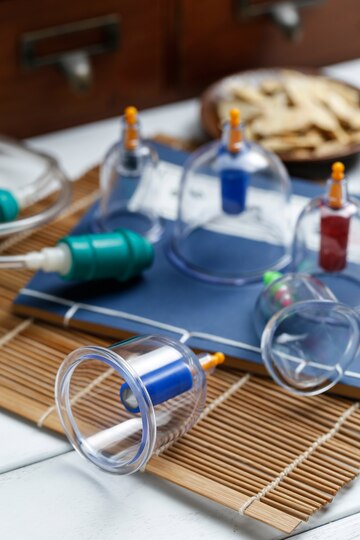Top 5 Myths About Wet Cupping Therapy in 2025

Wet cupping therapy has become increasingly popular in recent years, gaining recognition for its potential health benefits. Originating from ancient healing traditions in the Middle East and China, it involves the use of cups placed on the skin, creating a vacuum effect, and in the case of wet cupping, the skin is lightly pricked to allow a small amount of blood to be drawn out. While cupping therapy is gaining more acceptance worldwide, there are still a lot of myths and misconceptions that surround this practice.
In this post, we’ll address the top five myths about wet cupping therapy, providing you with accurate and helpful information to better understand this ancient therapeutic technique.
1. Myth: Wet Cupping Is Only for Pain Relief
One of the most prevalent myths about wet cupping therapy is that it is only useful for relieving pain. While wet cupping is commonly used to help alleviate pain from conditions like chronic back pain, arthritis, and muscle tension, its benefits extend far beyond pain management.
Wet cupping therapy can help improve circulation, detoxify the body, boost the immune system, and enhance overall well-being. It has been used to treat a wide variety of health conditions such as asthma, respiratory issues, headaches, migraines, and even anxiety and depression. By stimulating blood flow and promoting the removal of toxins, wet cupping helps restore balance to the body, providing holistic health benefits.
2. Myth: Wet Cupping Is Dangerous
A common misconception about wet cupping therapy is that it is unsafe or even dangerous. The truth is that when performed by a trained and experienced professional, wet cupping is generally a safe procedure with minimal risks.
The process involves using sterile, single-use needles to gently prick the skin and create small incisions. Cups are then placed over the skin, creating a vacuum that draws blood toward the surface. While there may be some minor discomfort or bruising, the risks associated with wet cupping are relatively low. It is important to ensure that the therapist follows strict hygiene and safety protocols, using clean, sterilized equipment to minimize the risk of infection.
Although side effects such as temporary bruising or slight dizziness can occur, these are typically short-lived. It’s important to remember that wet cupping therapy has been practiced for thousands of years in various cultures with a focus on its healing benefits.
3. Myth: Wet Cupping Is Extremely Painful
Another common myth is that wet cupping therapy is incredibly painful. While it’s understandable to assume that the process might be uncomfortable due to the bloodletting involved, the procedure is generally well-tolerated by most people.
The sensation of wet cupping is often described as a deep pressure or pulling sensation, similar to a massage. The suction created by the cups can feel tight on the skin, but it shouldn’t cause significant pain. The process of drawing out small amounts of blood from the body is done in a controlled and gentle manner, and most patients report feeling a sense of relief and relaxation during and after the therapy.
It’s worth noting that some people may experience mild discomfort during the procedure, but this usually subsides once the cups are removed. The benefits of wet cupping, such as improved circulation and detoxification, often outweigh any temporary discomfort.
4. Myth: Wet Cupping Is Only for Adults
Many people mistakenly believe that wet cupping therapy is only suitable for adults, but this is not the case. While wet cupping is often used to treat adult conditions such as back pain, stress, and fatigue, it can also be beneficial for children and young adults when performed appropriately and under professional supervision.
For children, wet cupping can help alleviate conditions like asthma, respiratory problems, allergies, and even digestive issues. It is particularly helpful for those who may not respond well to traditional medications or treatments. The procedure for children is modified to be gentler, and only specific areas of the body are treated.
As with adults, it’s important to ensure that the cupping therapist is properly trained to perform the therapy on children and has the necessary experience to provide safe and effective treatment.
5. Myth: Wet Cupping Leaves Permanent Scars
One of the most common myths about wet cupping therapy is that it leaves permanent scars. While it is true that wet cupping creates marks on the skin where the cups are applied, these marks are typically temporary and fade within a few days to a week.
The marks are a result of the suction process and the blood that is drawn to the surface of the skin. These marks are not scars but rather an indication that the body’s circulation has been stimulated, promoting healing and detoxification. The color of the marks can vary, ranging from red to purple, and they may be more noticeable immediately after the treatment.
However, the marks will gradually fade as the body processes and eliminates the blood and toxins. They do not leave permanent scarring. It’s important to understand that the marks are a normal part of the healing process and should not be a cause for concern.
Conclusion: Debunking the Myths and Embracing the Benefits of Wet Cupping Therapy
Wet cupping therapy has been used for centuries in traditional medicine practices and continues to be a valuable tool for promoting overall health and well-being. By addressing these common myths, we hope to provide a clearer and more accurate understanding of wet cupping therapy, allowing you to make an informed decision about whether it might be right for you.
If you’re curious about trying wet cupping therapy or learning more about its benefits, be sure to consult with a certified practitioner who can guide you through the process and tailor the treatment to your specific needs. For a deeper dive into the practice, explore our detailed guide on wet cupping therapy.








